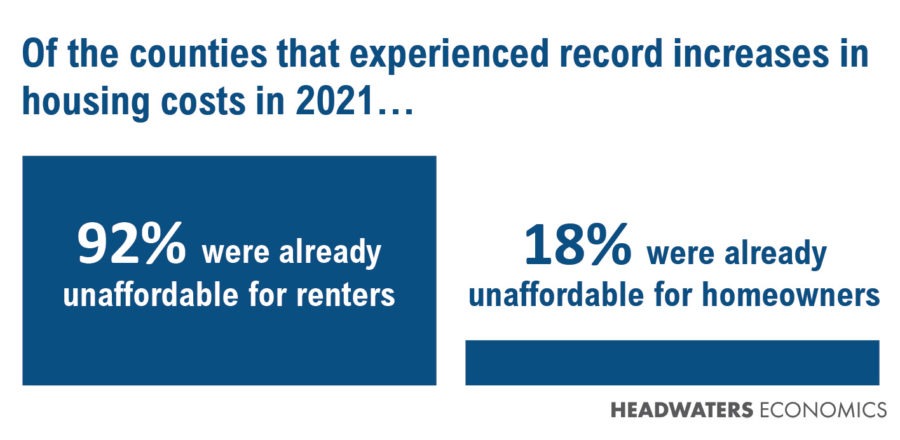More than 8 million households are behind on rent payments, due in part to the impacts of the coronavirus pandemic. To complicate matters, the national eviction moratorium has ended—struck down by the Supreme Court—and aid programs have proven difficult to access, with just 11% of housing aid distributed as of the end of August.
A new analysis of housing data shows that the unprecedented rise in housing prices since 2020 has affected renters more than homeowners, and especially in places that were already unaffordable.
Of the counties that experienced unprecedented housing price increases during the pandemic, 92% were already unaffordable for renters while just 18% were unaffordable for homeowners.

More expensive house prices mean more expensive rent
Even with high housing prices, homeowners have stable and predictable mortgage payments. Renters, on the other hand, are vulnerable to a dynamic market — they are not in control of their housing costs. When house prices rise, rents also will rise. First-time homebuyers may be priced out and opt to rent instead. Some homeowners will sell, cashing in on newfound equity. Add in pandemic-induced migration as many newly remote workers relocate to small cities, and there simply are not enough long-term rentals to meet the need. In response to increased demand, many landlords will increase rents, sometimes dramatically.
Four in 10 Americans are living in places that saw record-breaking rises in housing costs during the pandemic.
Natural disasters are exacerbating the housing crisis
Renters are often first and worst hit by home price increases because rental units are disproportionately located in areas more prone to natural disasters. When natural disasters destroy homes, they increase the demand—and prices for—the housing that remains. This is particularly true for rental housing, as people seek immediate housing while rebuilding. Disasters also disrupt residents’ finances, resulting in an increase in mortgage defaults and a decline in homeownership, further exacerbating the demand for rental housing. As the frequency and intensity of natural disasters like wildfire and flooding continue to increase, policies that recognize the particular challenges faced by renters are imperative.
Subscribe to our newsletter!
Communities across the U.S. are affected
Rising housing costs are not limited to large, coastal cities: in another analysis, we found rapidly increasing housing costs in all 50 states. In total, 21% of counties in the United States have experienced unprecedented housing cost increases. Cost increases in rural places can create particularly acute problems because fewer homes are available for rent.
The visualization below shows the U.S. counties that experienced unprecedented increases in price between July 2020 and July 2021. Highlighted in dark red are the counties in which at least 30% of households are paying at least 30% of their income for rent.
Data sources and methods
Housing cost data are from the Zillow Home Value Index (ZHVI), which represents the value for a typical single-family home between the 35th and 65th percentile.
The number of housing units for rent, rental cost, and income data are from the U.S. Census Bureau’s American Community Survey five-year average for 2015-2019. We define places with already high rent burdens as communities where at least 30% of households are paying at least 30% of income toward rent.












